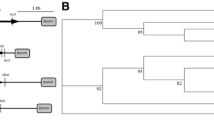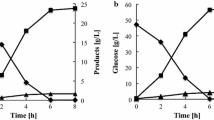Abstract
A major problem in fermenting xylose in lignocellulosic substrates is the presence of glucose and mannose which inhibit xylose utilization. Previous studies showed that catabolite repression in some yeasts is associated with hexokinases and that deletion of one of these gene(s) could result in derepressed mutant strain(s). In this study, the hxk1 encoding hexokinase 1 in Scheffersomyces stipitis was disrupted. The ∆hxk1 SS6 strain retained the ability to utilize the main hexoses and pentoses commonly found in lignocellulosic hydrolysates as efficiently as the wild-type (WT) strain. SS6 also fermented the dominant sugars to ethanol; however, on xylose, the ∆hxk1 strain produced more xylitol and less ethanol than the WT. On mixed sugars, as expected the WT utilized glucose ahead of xylose and xylose utilization did not commence until all the glucose was consumed. In contrast, the ∆hxk1 mutant showed derepression in that it started to utilize xylose even when considerable glucose (about 1.72 %, w/v) remained in the medium. Similarly, mannose did not repress xylose utilization by the ∆hxk1 mutant and xylose and mannose were simultaneously utilized. The results are of interest in efforts to engineer yeast strains capable of efficiently utilizing glucose and xylose simultaneously for lignocellulosic biomass conversion.




Similar content being viewed by others
References
Bae YH, Kweon DH, Park YC, Seo JH (2014) Deletion of the HXK2 gene in Saccharomyces cerevisiae enables mixed sugar fermentation of glucose and galactose in oxygen-limited conditions. Process Biochem 49:547–553
Bajwa PK, Pinel D, Martin VJ, Trevors JT, Lee H (2010) Strain improvement of the pentose-fermenting yeast Pichia stipitis by genome shuffling. J Microbiol Methods 81:179–186
Bajwa PK, Shireen T, D’Aoust F, Pinel D, Martin VJJ, Trevors JT, Lee H (2009) Mutants of the pentose-fermenting yeast pichia stipitis with improved tolerance to inhibitors in hardwood spent sulfite liquor. Biotechnol Bioeng 104:892–900
Barbosa MDS, Lee H, Collins-Thompson DL (1990) Additive effects of alcohols, their acidic by-products, and temperature on the yeast Pachysolen tannophilus. Appl Environ Microbiol 56:545–550
Bicho PA, Runnals PL, Cunningham JD, Lee H (1988) Induction of xylose reductase and xylitol dehydrogenase activities in Pachysolen tannophilus and Pichia stipitis on mixed sugars. Appl Environ Microbiol 54:50–54
Entian KD, Frohlich KU (1984) Saccharomyces cerevisiae mutants provide evidence of hexokinase PII as a bifunctional enzyme with catalytic and regulatory domains for triggering carbon catabolite repression. J Bacteriol 158:29–35
Goffrini P, Ficarelli A, Ferrero I (1995) Hexokinase activity is affected in mutants of Kluyveromyces lactis resistant to glucose repression. Microbiology 141:441–447
Harner NK, Wen X, Bajwa PK, Austin GD, Ho CY, Habash MB, Trevors JT, Lee H (2015) Genetic improvement of native xylose-fermenting yeasts for ethanol production. J Ind Microbiol Biotechnol 42:1–20
Jeffries TW, Grigoriev IV, Grimwood J, Laplaza JM, Aerts A, Salamov A, Schmutz J, Lindquist E, Dehal P, Shapiro H, Jin YS, Passoth V, Richardson PM (2007) Genome sequence of the lignocellulose-bioconverting and xylose-fermenting yeast Pichia stipitis. Nat Biotechnol 25:319–326
Lee H (1992) Reversible inactivation of D-xylose utilization by d-glucose in the pentose-fermenting yeast Pachysolen tannophilus. FEMS Microbiol Lett 92:1–4
Lobo Z, Maitra PK (1977) Resistance to 2-deoxyglucose in yeast: a direct selection of mutants lacking glucose-phosphorylating enzymes. Mol Genet Genomics 157:297–300
Rose MD, Winston F, Hieter P (1990) Methods in yeast genetics—a laboratory course manual. Cold Spring Harbor Laboratory Press, New York
Scorer CA, Clare JJ, Mccombie WR, Romanos MA, Sreekrishna K (1994) Rapid selection using G418 of high copy number transformants of Pichia pastoris for high-level foreign gene expression. Biotechnology 12:181–184
Slininger PJ, Thompson SR, Weber S, Liu ZL, Moon J (2011) Repression of xylose-specific enzymes by ethanol in Scheffersomyces (Pichia) stipitis and utility of repitching xylose-grown populations to eliminate diauxic lag. Biotechnology Bioengneering 108:1801–1815
Sreenath HK, Jeffries TW (1999) 2-Deoxyglucose as a selective agent for derepressed mutants of Pichia stipitis. Appl Biochem Biotechnol 77–79:211–222
Webb SR, Lee H (1990) Regulation of D-xylose utilization by hexoses in pentose-fermenting yeasts. Biotechnol Adv 8:685–697
Wedlock DN, James AP, Thornton RJ (1989) Glucose-negative mutants of Pachysolen tannophilus. J Gen Microbiol 135:2019–2026
Wedlock DN, Thornton RJ (1989) A hexokinase associated with catabolite repression in Pachysolen tannophilus. J Gen Microbiol 135:2013–2018
Weirich J, Goffrini P, Kuger P, Ferrero I, Breunig KD (1997) Influence of mutations in hexose-transporter genes on glucose repression in Kluyveromyces lactis. Eur J Biochem 249:248–257
Youderian P, Lawes MC, Creighton C, Cook JC, Saier MH (1999) Mutations that confer resistance to 2-deoxyglucose reduce the specific activity of hexokinase from Myxococcus xanthus. J Bacteriol 181:2225–2235
Zimmermann FK, Scheel I (1977) Mutants of Saccharomyces cerevisiae resistant to carbon catabolite repression. Mol Genet Genomics 154:75–82
Acknowledgments
This research was supported by the Natural Sciences and Engineering Research Council (NSERC) through the NSERC Bioconversion Network and BioFuelNet Canada. MD was the recipient of the Webster Post-doctoral fellowship award.
Author information
Authors and Affiliations
Corresponding author
Electronic supplementary material
Below is the link to the electronic supplementary material.
Rights and permissions
About this article
Cite this article
Dashtban, M., Wen, X., Bajwa, P.K. et al. Deletion of hxk1 gene results in derepression of xylose utilization in Scheffersomyces stipitis . J Ind Microbiol Biotechnol 42, 889–896 (2015). https://doi.org/10.1007/s10295-015-1614-9
Received:
Accepted:
Published:
Issue Date:
DOI: https://doi.org/10.1007/s10295-015-1614-9




